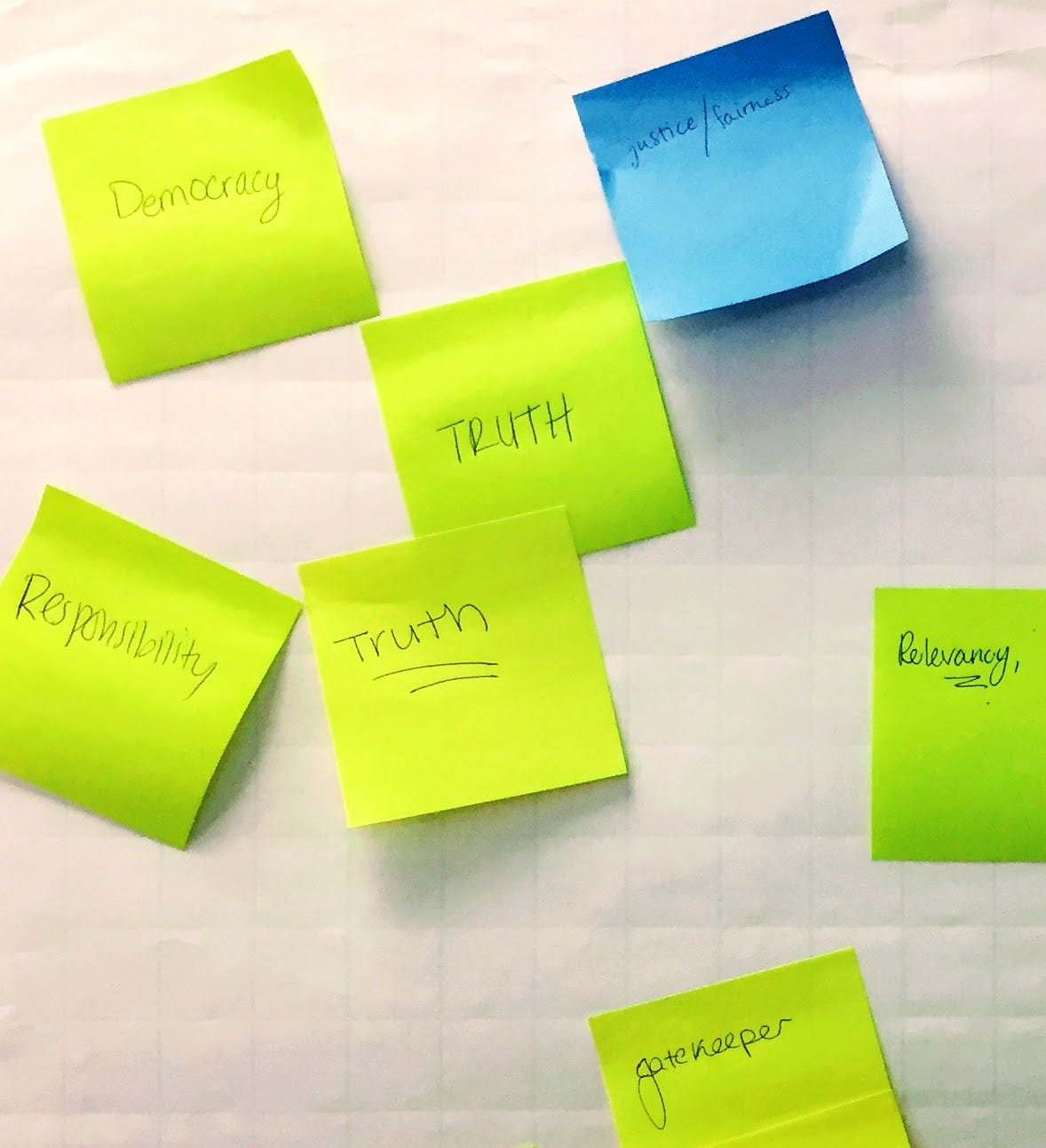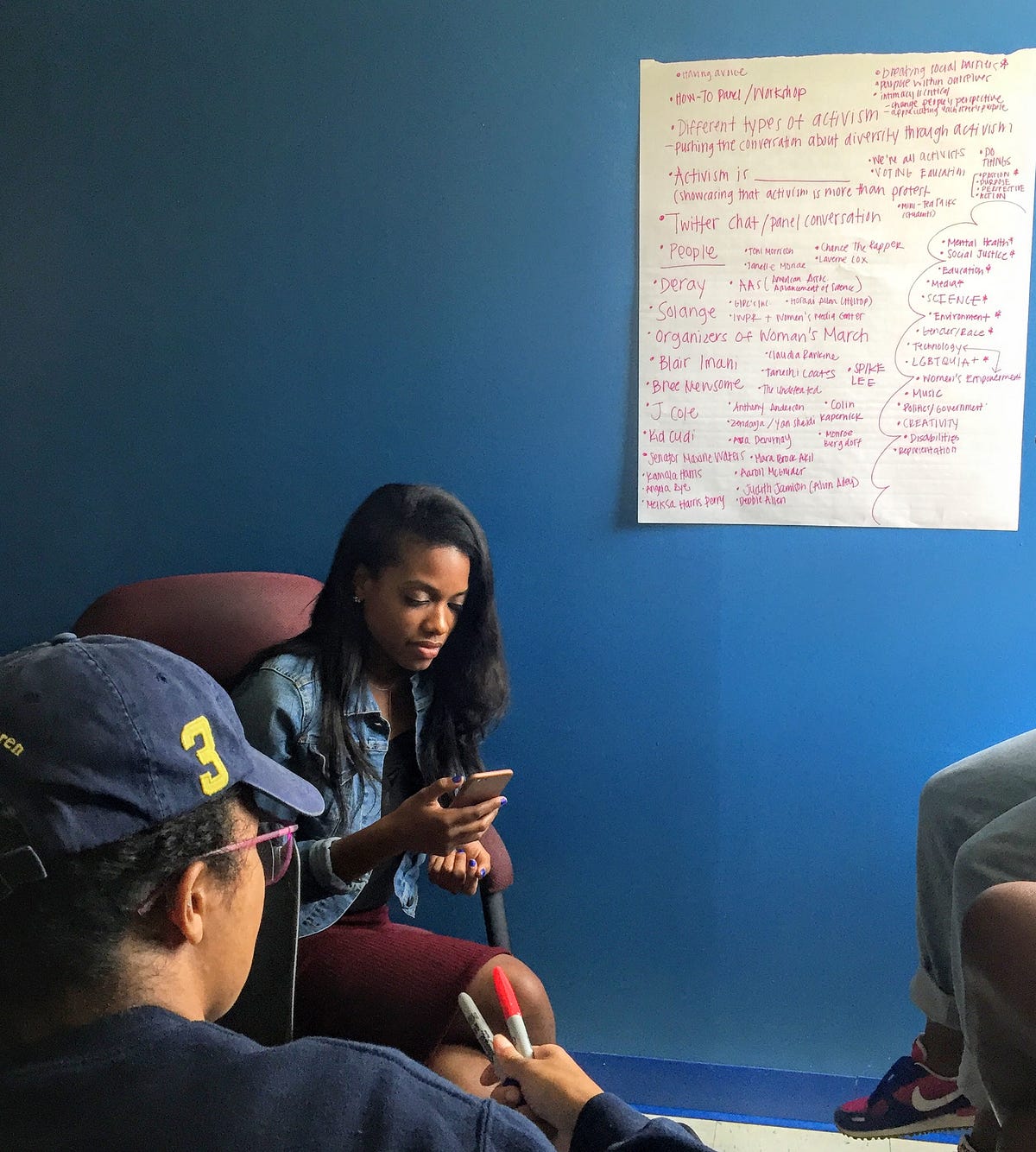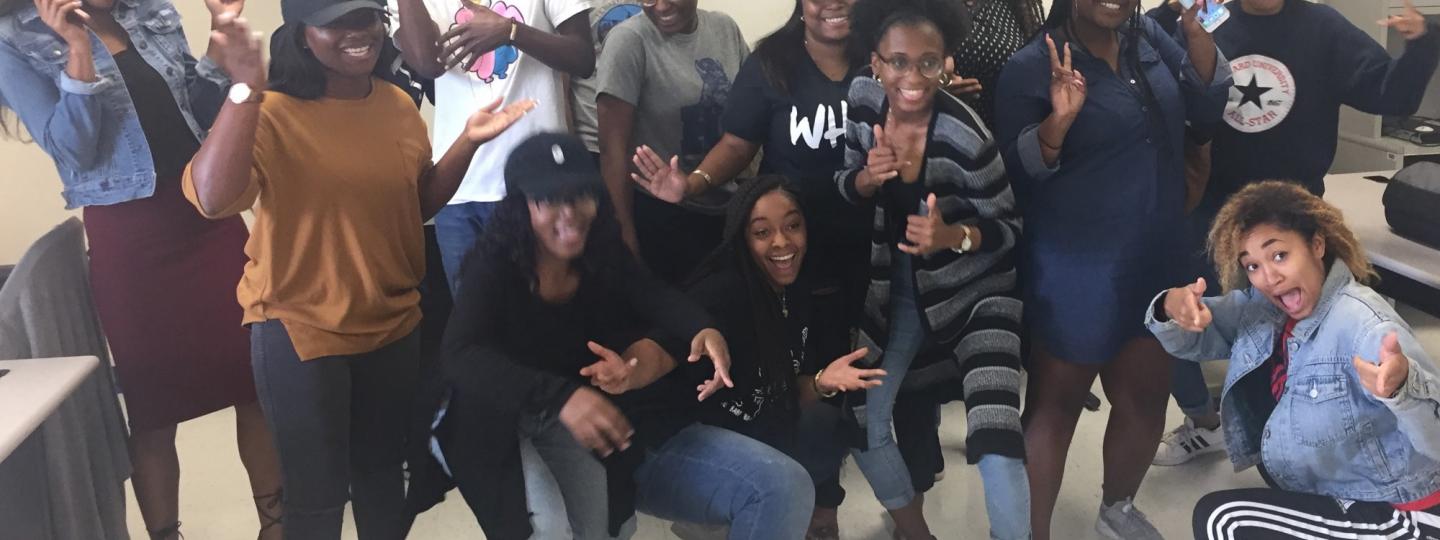The original room reserved for the Friday afternoon and Saturday morning deep-dive into accountability journalism and civil discourse development was spacious, tech-ready and easily accessible. It was also in a residence hall where a second-floor shower had sprung a leak.
Campus project leader and The Hilltop newspaper editor-in-chief Jazmin Goodwin was already working the phones. She graciously guided co-facilitator Bob Stains and me to a classroom, all while texting and answering calls from behind oversized eyeglasses and a black “Working Girl” baseball cap. Jazmin carried supplies, wrangled a presentation-sized pad of paper and updated the 30-some fellow students expected to attend the sessions with an air of calm confidence.
We were in capable hands.
Students found their way into the new space, and while they wore expressions that mixed curiosity and suspicion, their handshakes were firm and friendly. They sat in a wide half-circle — some were long-time friends, others vaguely recognized each other from shared classes. They included Jazmin and many new editors from The Hilltop, the storied Howard publication co-founded by Zora Neale Hurston in 1924; program directors from campus radio station WHBC and its general manager Chanique Rochester; and representatives from the campus chapter of the Association of Black Journalists, including its president, Sydney Williams. All three groups had applied to be a part of the pilot project with Poynter.
We started by handing each student a small stack of sticky notes and asking them to write down one word or phrase that came to mind when they heard the words “accountability journalism.”
“Truth.” “Accuracy.” “Democracy.” “Justice.” “Vulnerability.” “Integrity.” “Authenticity.” “Credibility.” “Morality.” “Watchdog.” “Gatekeeper.” “Tautology: Civic duty dispelling rhetoric to report information.” (Defined as a type of logic, as we drew out through discussion: something that is true no matter the interpretation.)
With only a pack of fresh markers and multi-colored sticky notes, we had already begun digging below the surface of journalistic practices to uncover a broader set of journalistic responsibilities.
Bob followed up with an exercise he calls “wise person.” Each participant recalled a wise person who had influenced their decision to become a journalist. Bob, who worked as a therapist before turning his talents to community dialogue, created constraints that allowed each student to share their “wise person” story freely. No interruptions, followed by intentional moments of reflection, silence and, finally, connection.
One student shared how her family’s African roots heightened the pressure on her to become a doctor or lawyer. Another spoke of being the only woman of color working as an NBA public relations intern over the summer. Another spoke of balancing his drive to excel in academics and sports with the joy he felt when expressing his creativity.
When Bob told me later that he felt we were sharing sacred space with the students, I agreed, but with a journalistic twist. As I listened to the students, I heard deeply authentic interviews. I heard engaged storytellers home in on detail and meaning. It was natural and illuminating, as the best paths to story tend to be.
During the Saturday session, the students were looser and more easy with one another. As they considered the concept of objectivity, we compared the reporting process to the “ladder of inference.”
The “ladder,” which Bob often uses in systems change and organizational leadership circles, breaks down how humans move from observing facts to gaining understanding from them and taking action based upon that understanding.
The students eagerly applied the ladder to real life. They examined how the process of selecting facts and deciding whether to include them in a story about a campus visit by high schoolers wearing Make America Great Again hats had shaped coverage across varied media outlets. They ended with a list of as-yet unanswered questions, as well as with an understanding that through this single incident, “others” — from social media to national media — had largely shaped a narrative of life at Howard.
In their disdain for the coverage about their school, I heard a familiar refrain. But I couldn’t quite place it until we began to map out their required campus accountability journalism project: a two-day conference slated for January called “LEGACY: Building Community, Upholding Culture and Restoring Activism.”
From The Hilltop’s application: “The conference will focus on the pillars of community, culture and activism as they relate to creating a legacy for our university, millennials and media. . . .Our staff will also work to implement creative and digital content focused on these pillars by highlighting community issues and figures, providing updates on current and past protests, and participating in discussions that educate and uphold minority culture and student- and race-related issues. Further, through the usage of a central hashtag, focus groups and monthly Hilltop-hosted events, we will further reinforce the importance of these pillars and dialogue about them.”
The students divided into groups based on the pillar that most appealed to them, then talked about ways to bring each topic to life through journalism and community conversations. They talked about stories and podcasts and public art. They were ambitious — and excited.
I checked in with each group and looked at their major themes, written in neat block letters and scrawled on notebook paper: Activism. Culture. Community.
Suddenly, the connection was as clear as the sky outside. After the training, I rushed to find the full quote, only fragments of which in exist my memory, that I thought might echo the purpose and passion of these talented young journalists.
It dates back 190 years, to the first issue of the first African American newspaper in America, Freedom’s Journal:
“We wish to plead our own cause. Too long have others spoken for us. Too long has the public been deceived by misrepresentation of things which concern us dearly. It shall ever be our daily duty to vindicate our brethren, when oppressed, and to lay the cause before the public.” — Freedom’s Journal, 1927
But these 21st century students will assuredly add their own twist. To them, the appeal of journalism is rooted in the power of shaping their own narratives and helping others to do the same.
They see political and ideological debates too often simplified by protests and sound bytes, even on their own campus. As they talked about their conference, they explored new approaches to the same issues that inspired the writers of Freedom’s Journal.
Here are just a few project ideas the group discussed pursuing before and after the January conference:
- Hosting a series of community conversations with long-time neighborhood residents, newer residents viewed as “gentrifiers” and Howard students to address points of conflict and concern for the future.
- Creating a series of stories or videos with neighborhood guides showing the changing demographics of Northwest D.C. and its impact on Howard and local residents.
- Launching multi-media stories focused on issues of “culture vultures,” or groups that appropriate black culture for their own benefit, that explore the line that separates inspiration and flattery from a more insidious brand of cultural erasure.
- Creating visual and audio explorations of the diversity on Howard’s campus, which includes a growing population of international students as well as a wide mix of socio-economic backgrounds.
- Launching a series, perhaps via the radio station, that takes a realistic look at challenges faced in African American communities, including colorism and the financial consequences of institutional oppression and poverty.
- Creating a public art display allowing community members to share their definitions of activism, moving beyond protest to examine the many passions and purposes that drive Howard students forward — from environmentalism to LGBTQ rights.
- Hosting a podcast featuring voices of a wide range of activists, including heavy-hitting Howard alumni and pop culture icons, inviting them to share their journeys and offer advice to students.
We are in capable hands, indeed.
Next stop: Virginia Polytechnic Institute, Sept. 15–16.






